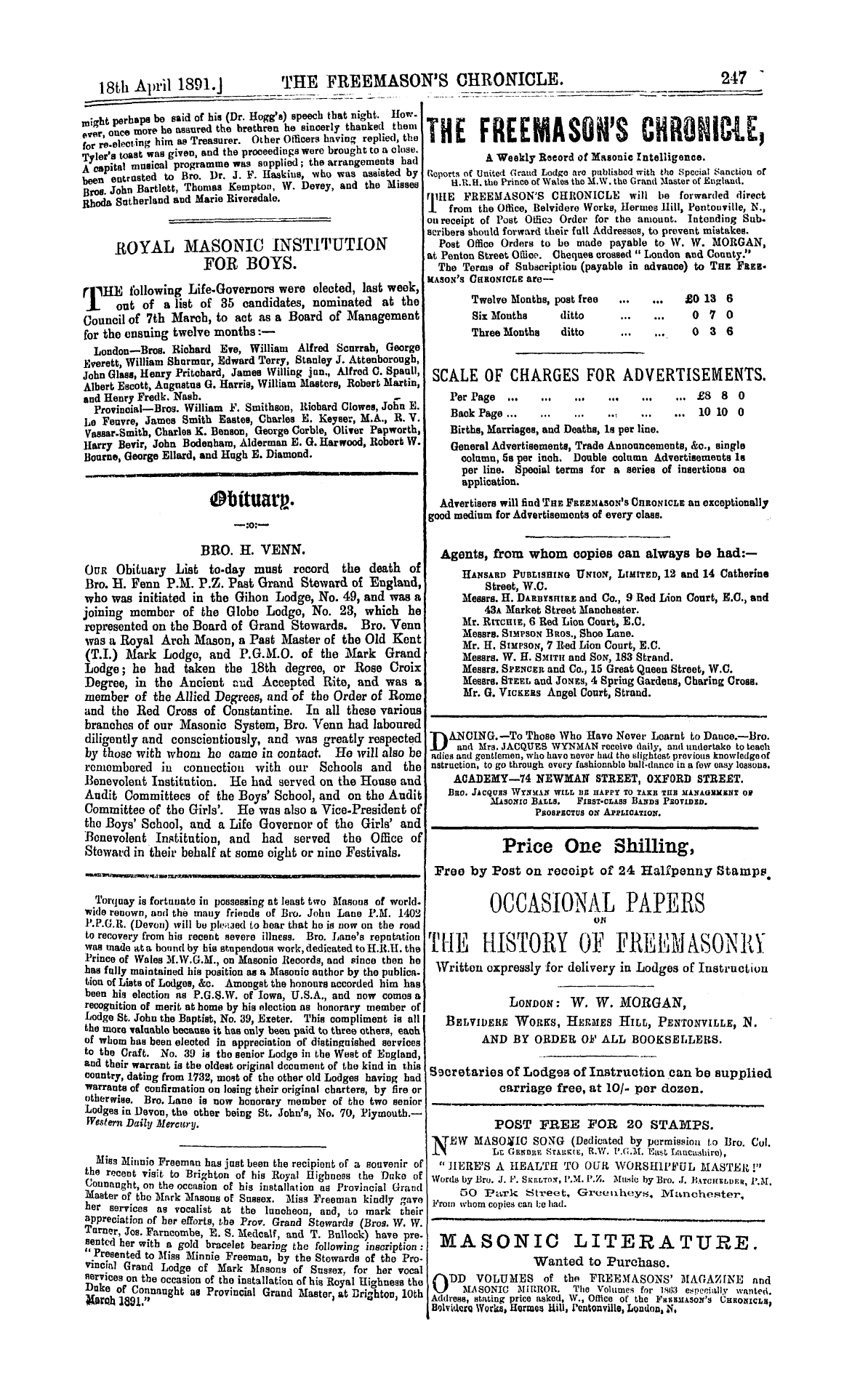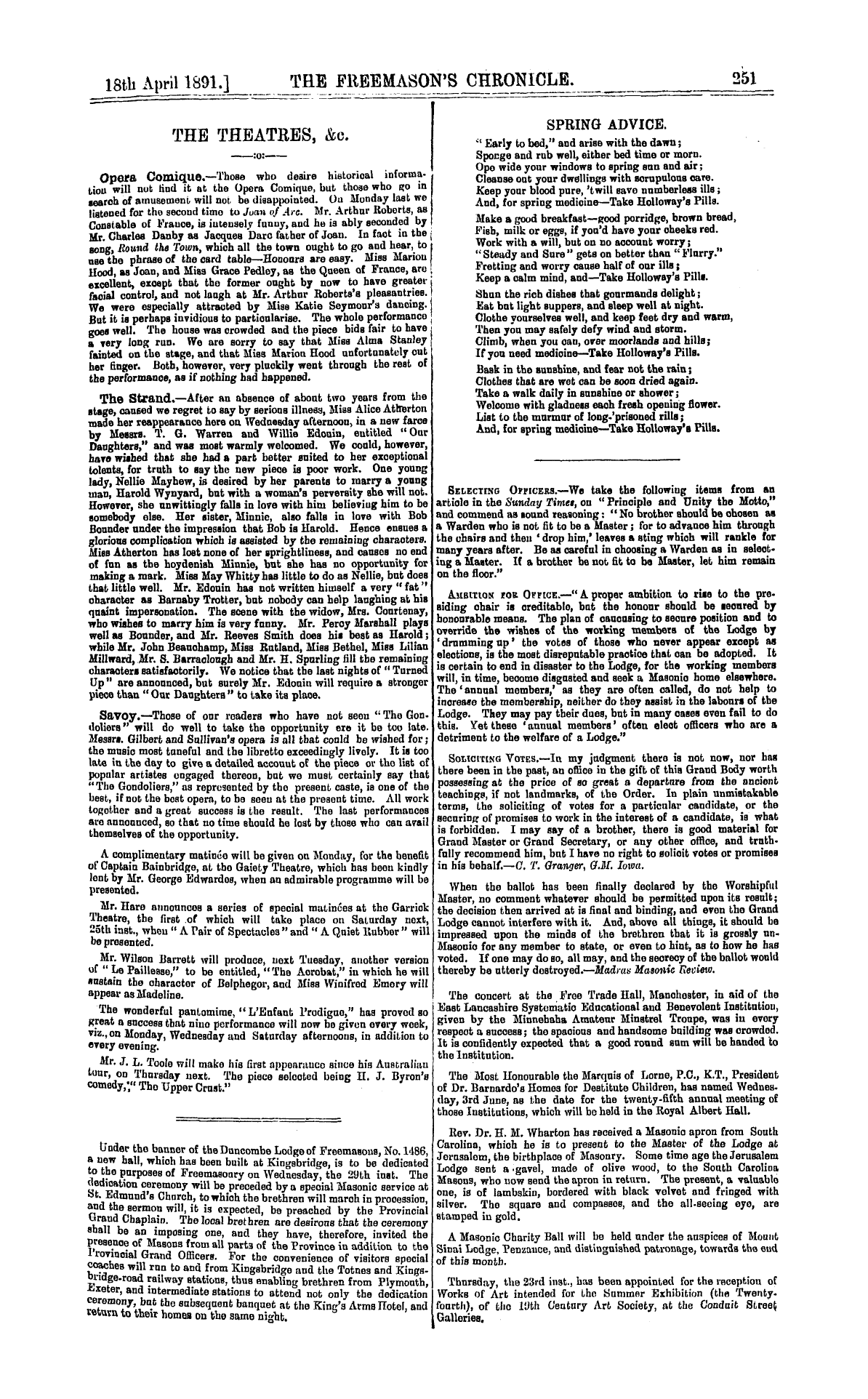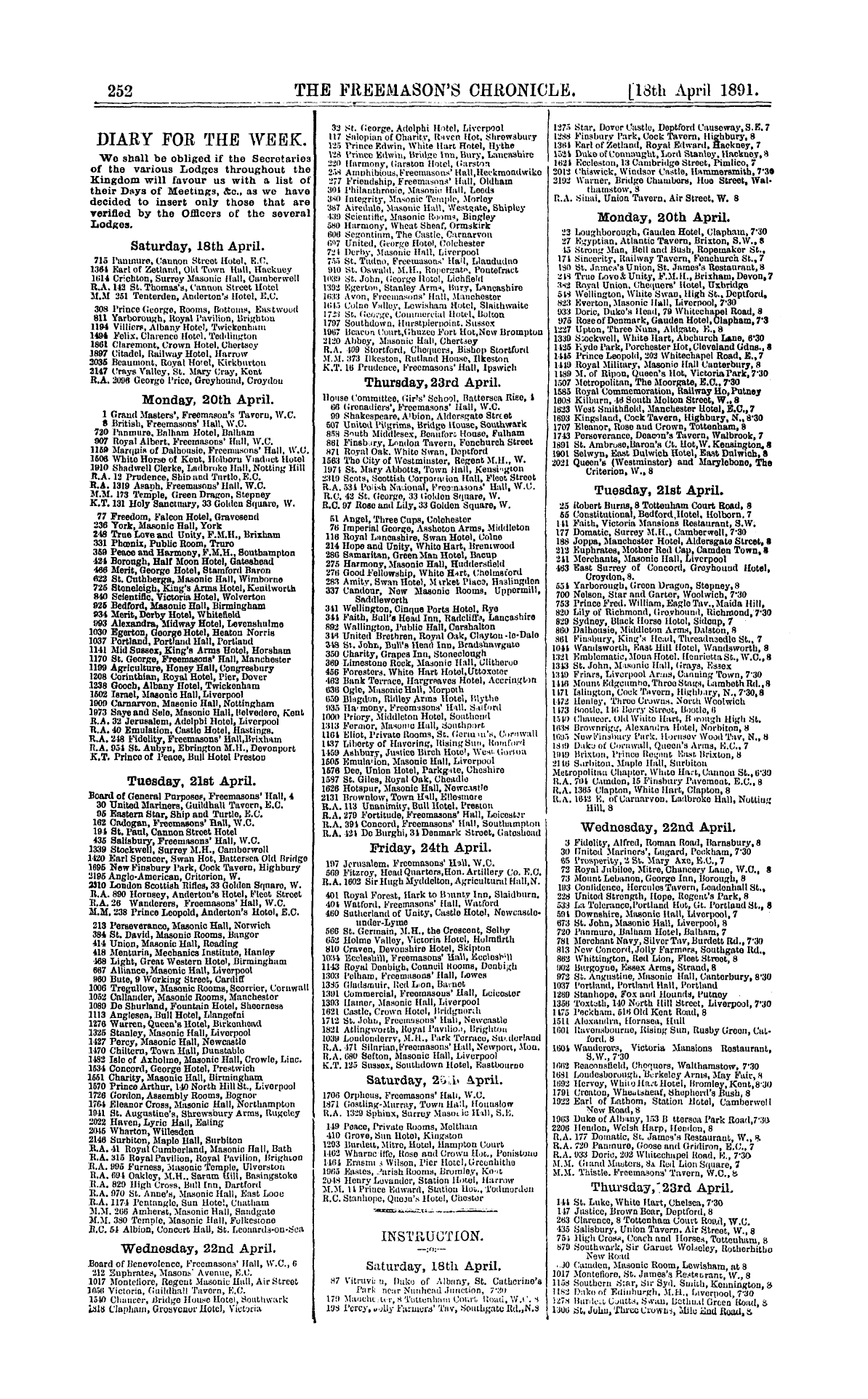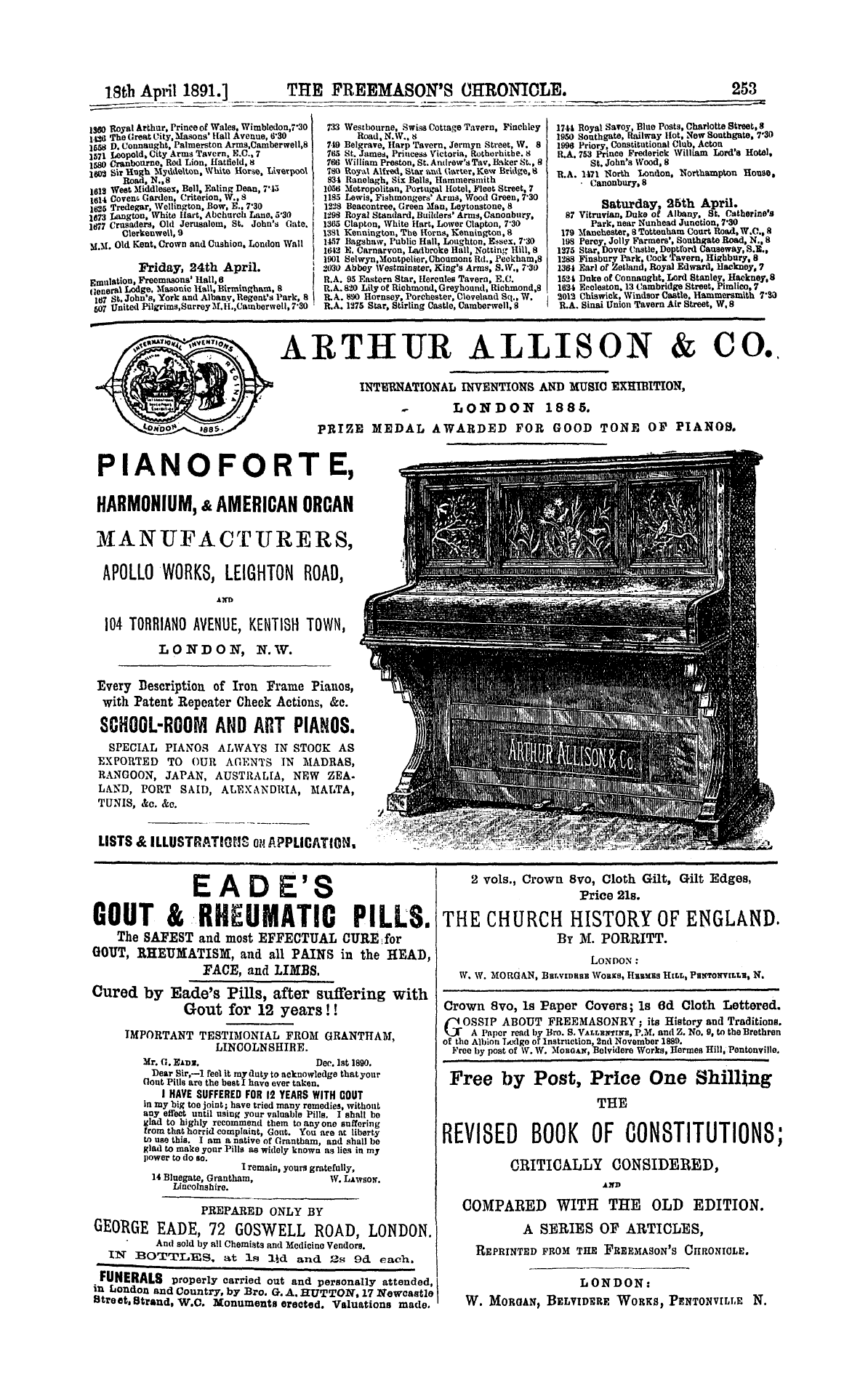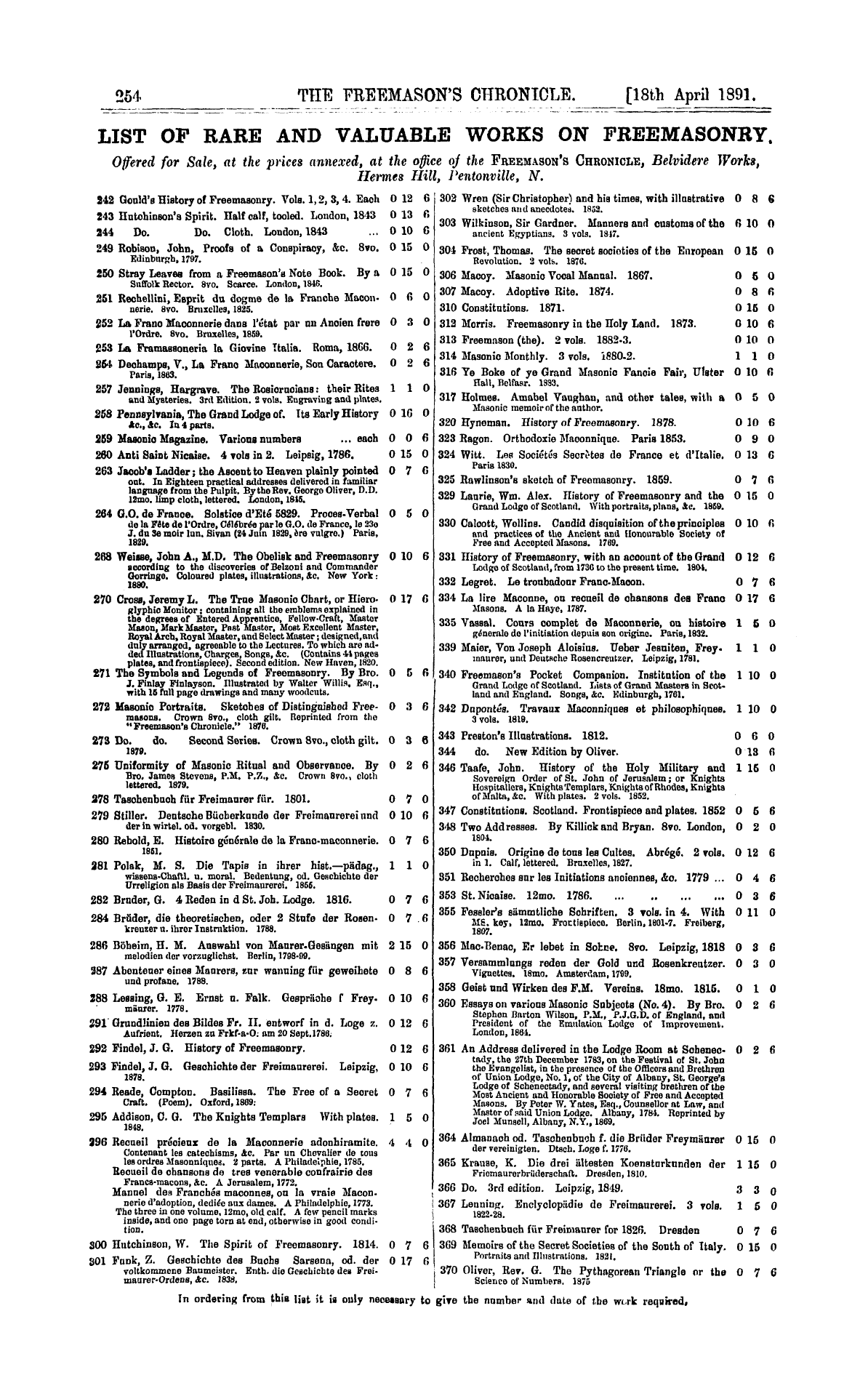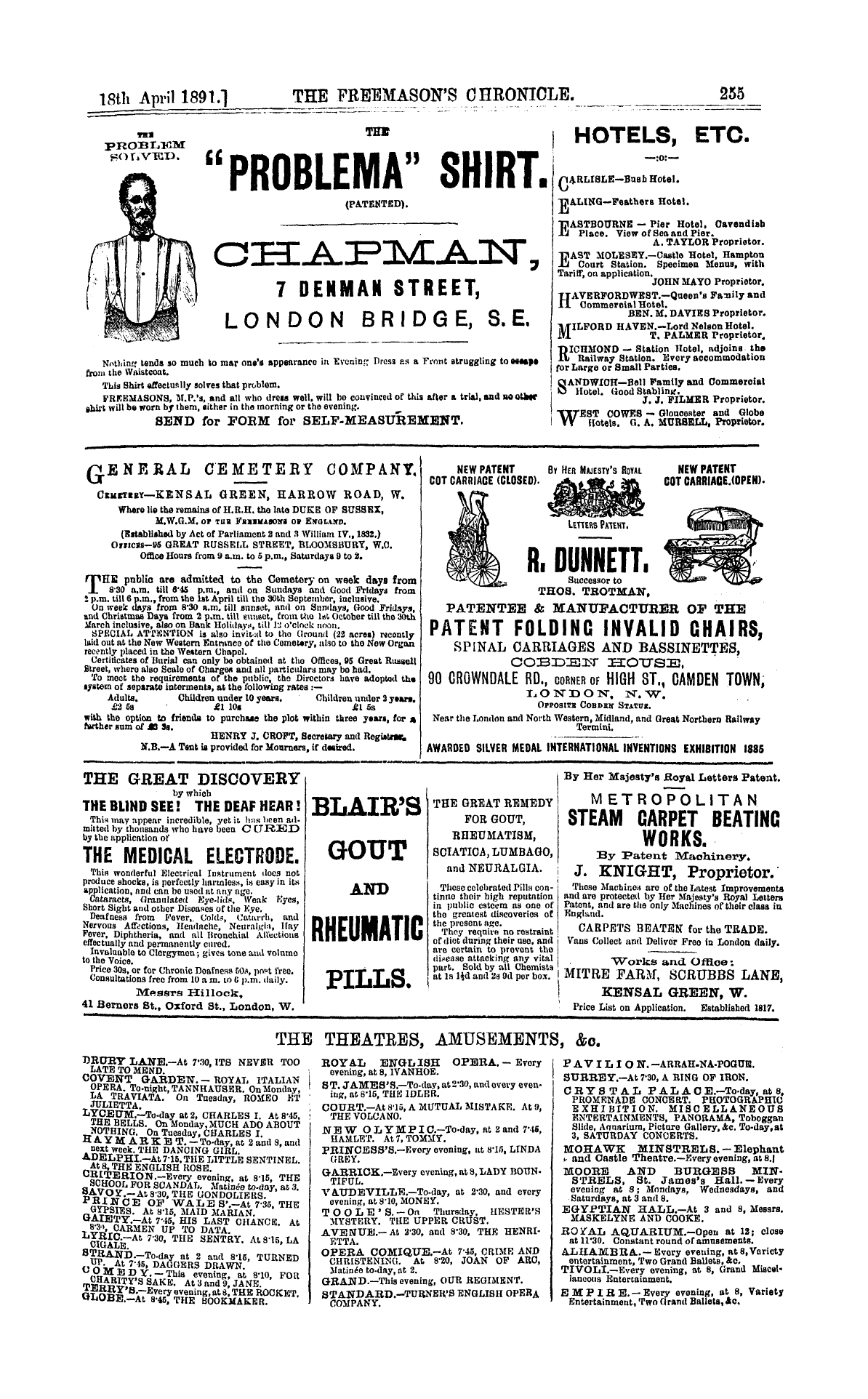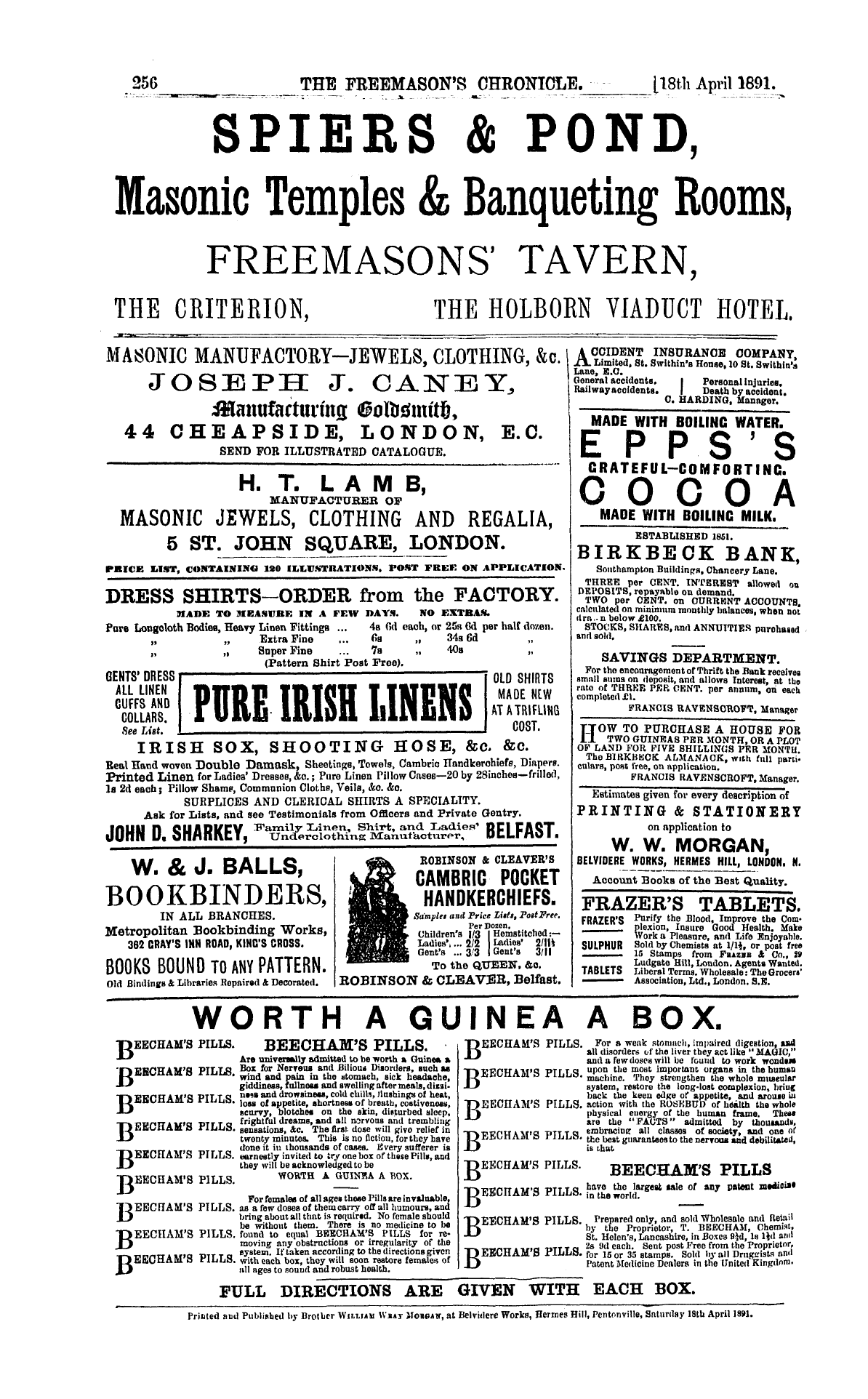-
Articles/Ads
Article MASONIC LABOUR. ← Page 2 of 2 Article MASONRY—OPERATIVE AND SPECULATIVE. Page 1 of 1 Article MASONRY—OPERATIVE AND SPECULATIVE. Page 1 of 1 Article PAST AND PRESENT. Page 1 of 1 Ad Untitled Page 1 of 1
Note: This text has been automatically extracted via Optical Character Recognition (OCR) software.
Masonic Labour.
not , should be a Masonic labourer , and if he is , he will insure for himself a life-time of Masonic instruction and p leasure . —Keystone .
Masonry—Operative And Speculative.
MASONRY—OPERATIVE AND SPECULATIVE .
WHAT was Operative Masonry , and what were its secrets ? When we of the Mystic Tie speak of Operative Masonry , we generally mean the art of
designing and building , as ifc was practiced by the travelling Freemasons of the Middle Ages , those skilful workmen to whose genius and labours we are indebted for the mighty church edifices whioh adorn almost every old city of Europe , structures whose marvellous beauty excites tbe wonder and admiration of all who can appreciate the
beautiful in art and whose strength and solidity have enabled them to withstand the storms and to resist all the
inroads of time . By Operative Masonry we mean Gothic architecture which , it is now admitted , was the invention of these travelling Freemasons or of monkish architects attached to their Fraternity . In proof of this , it is stated that nearly all the old
churches and cathedrals of the various countries in Europe , whioh were constructed afc the same epoch of time , are manifestly built from similar designs ; that churches may be found in fche south of Italy which resemble in nearly every particular churches in the north of Scotland . These
structures must , therefore , have been the work of a company of builders working after the same plans , who were not confined to any particular country , and who possessed facilities for holding free and unrestricted intercourse with each other . This company was the Guild
of Travelling Freemasons . In the Middle Ages , down to quite recent times indeed , every guild or association of skilled artisans , had its secrets , pertaining to the handicraft which its members pursued . These secrets were strictly guarded , none bnt
those youths regularly bound apprentices to the trade for a space of five or seven years , were ever permitted to have any acquaintance with them , and none but those who could produce satisfactory proofs of having duly served such an apprenticeship , were suffered to work afc that trade .
Those who had never given them the required probation , were regarded as irregular , no skilled Craftsman would work in their company , no master was permitted to employ them , especially in cities where guilds of workmen were established .
Some guilds had also words of recognition , by which fellow-artisans of the same trades could make themselves known to each other , but these were merely incidental . The real secret of the craft was a knowledge of all those hidden and guarded mysteries , which pertained to the art it professed .
Of all these Craft secrets , those which belonged to the art of Masonry , were the greatest and the most profound , and they were accordingly the most closely and carefully guarded . Gothic architecture was the one distinguishing art of the Middle Ages . Poetry , painting and literature
were in their early infancy , and the great imaginative intellect of thafc epoch expressed their ideas and breathed forth their souls , in those wondrous creations of stone and marble , which seem destined to remain monuments of their genius , as long as fche world endures .
Those who first caught the idea of awakening high religions aspirations in the human heart by means of the soaring pinnacle and the lofty arch , and of giving birth to deep and solemn thoughts by the mystical blending of light and shade , treasured these discoveries in their inmost
soula , and bequeathed them as a legacy to their successors . The task of fitly expressing them in some wonderful architectural creation , such as Strasburg Minster , required the labour of hundreds of hands through several generations . But no one was judged capable of doing anv part
work wtnch demanded either artistic or mechanical skill , unless he had been regularly admitted a member of the company of builders and had been for some time under the instruction of expert Craftsmen .
lo construct material temples , according to the rules and principles of Gothic architecture , was fche object of Uperafave Masonry ; to keep secret from fche outer world the knowled ge of their noble art , was the obligation imposed on the Apprentice and tbe Craftsman .
Masonry—Operative And Speculative.
The modes of recognition , tbe signs and passwords were only incidentals ; safeguards to prevent impostors from becoming acquainted with tho mysteries of the science and from passing themselves off at assemblies of their brethren as regularly instructed Craftsmen . —New York Dispatch .
Past And Present.
PAST AND PRESENT .
THE activity manifest during the present generation in the various fields of investigation and discovery is , when one reflects upon it , more than wonderful . It is not merely by a running " to and fro" that knowledge is increased and increasing in the earth ; it is rather by addin g to tho achievements of our own day and generation
those stores of knowledge once possessed by ancient peoples and lost , but which , during our life-time , have been rediscovered , reclaimed , and utilized , thafc in a large measure accounts for the activity that is , and gives promise of greater in tho coming years . The rediscovered , dust
from the civilizations of the' y pasfc , here and abroad , is so muoh treasure added to our present store ; and though unwillingly laid away by its former possessors , it is to us , though second-hand , none the less treasure , and more valuable to us than the shining idol , before which so many of us make our too-willing prostrations .
This wonderful activity , which is observable on every hand , presents one of the strongest proofs that ,
" Through all the agea one increasing purpose runs . " Knowledge grows by what it feeds on . Its desire is as unsatiable as death , and its possession furnishes the power and the sustenance for wisdom and righfc understanding . It is remarkable , that all civilizations of the ancients
appear to have been moved by similar tastes and aspiration , though each for itself , gratified its tastes and aspirations according to its several environments ; thus , the Oriental , the Egyptian , the Grecian , and the Roman styles of architecture , may be referred to , as an epitomised
expression of the qualification of taste , extant during their periods . It may also be remarked , that each of these expressions of ancient taste is perfect . No change ever made in either of these styles of architecture has resulted in improvement . Every attempt at change has resulted in marring it .
It appears , too , that the tastes of fche ancient peoples were similar to the moderns , the chief difference being the distinctness of the ancient modes of expression ; and in nothing is this more noteworthy than in their architecture . It was the expression of an ideal wrought into almost
imperishable , material structure , quite imperishable , as against the influences of time and fche elements , though , unhappily , not as against subsequent vandalism What we are pleased to designate " barbaric splendour , " is and was the expression of a civilization and a taste , which ,
thanks to the investigator s irresistible pick and fche patient discoverer ' s spade , may yet be found to have been little behind or less , if not ahead of or more than ours . The treasures of letters , science , and art , recovered from the
ruins of these ancient splendours , more than two millenniums old , ought to be regarded as sufficient proof of this . The very Writ itself is receiving reinforcement and verification of its letter , through the results of the achievement by pick and spade .
Each additional testimony of the origin , grandeur and glory of an ancient dynasty has stimulated the activity of modern peoples , and shapened the desire to press forward for more knowledge and brighter light . Many of the reclaimed wonders of those remote ages , in whose presence
we stand to-day in mute admiration , are but the crystallizations of a knowledge and a skill and an intelligence differing in kind only , scarcely in degree , from ours . In many features they are our silent schoolmasters , whose mute examples in art , letters , even science itself , we
are hardly able to surpass , if haply we may equal ; while some remain the unsolvable riddle of our astonished admiration , and through their very inexplicableness stimulate and renew , day by day , the wonderful activity manifest among modern peoples in tho fields of discovery and reclamation . —Masonic Review .
Ad00304
IMPORTANT NOTICE . —Confidential Advice free per post to all in weak and failing health , with loss of strength and vitality . Fifty years experience in Nervous Ailments . Address , tlie Secretary , 3 Fitzallnn Square , Sheffield . Form of Correspondence Free . Write to-day . CO years experience , All diseases arising from impurity of the blood absolutely cured ,
Note: This text has been automatically extracted via Optical Character Recognition (OCR) software.
Masonic Labour.
not , should be a Masonic labourer , and if he is , he will insure for himself a life-time of Masonic instruction and p leasure . —Keystone .
Masonry—Operative And Speculative.
MASONRY—OPERATIVE AND SPECULATIVE .
WHAT was Operative Masonry , and what were its secrets ? When we of the Mystic Tie speak of Operative Masonry , we generally mean the art of
designing and building , as ifc was practiced by the travelling Freemasons of the Middle Ages , those skilful workmen to whose genius and labours we are indebted for the mighty church edifices whioh adorn almost every old city of Europe , structures whose marvellous beauty excites tbe wonder and admiration of all who can appreciate the
beautiful in art and whose strength and solidity have enabled them to withstand the storms and to resist all the
inroads of time . By Operative Masonry we mean Gothic architecture which , it is now admitted , was the invention of these travelling Freemasons or of monkish architects attached to their Fraternity . In proof of this , it is stated that nearly all the old
churches and cathedrals of the various countries in Europe , whioh were constructed afc the same epoch of time , are manifestly built from similar designs ; that churches may be found in fche south of Italy which resemble in nearly every particular churches in the north of Scotland . These
structures must , therefore , have been the work of a company of builders working after the same plans , who were not confined to any particular country , and who possessed facilities for holding free and unrestricted intercourse with each other . This company was the Guild
of Travelling Freemasons . In the Middle Ages , down to quite recent times indeed , every guild or association of skilled artisans , had its secrets , pertaining to the handicraft which its members pursued . These secrets were strictly guarded , none bnt
those youths regularly bound apprentices to the trade for a space of five or seven years , were ever permitted to have any acquaintance with them , and none but those who could produce satisfactory proofs of having duly served such an apprenticeship , were suffered to work afc that trade .
Those who had never given them the required probation , were regarded as irregular , no skilled Craftsman would work in their company , no master was permitted to employ them , especially in cities where guilds of workmen were established .
Some guilds had also words of recognition , by which fellow-artisans of the same trades could make themselves known to each other , but these were merely incidental . The real secret of the craft was a knowledge of all those hidden and guarded mysteries , which pertained to the art it professed .
Of all these Craft secrets , those which belonged to the art of Masonry , were the greatest and the most profound , and they were accordingly the most closely and carefully guarded . Gothic architecture was the one distinguishing art of the Middle Ages . Poetry , painting and literature
were in their early infancy , and the great imaginative intellect of thafc epoch expressed their ideas and breathed forth their souls , in those wondrous creations of stone and marble , which seem destined to remain monuments of their genius , as long as fche world endures .
Those who first caught the idea of awakening high religions aspirations in the human heart by means of the soaring pinnacle and the lofty arch , and of giving birth to deep and solemn thoughts by the mystical blending of light and shade , treasured these discoveries in their inmost
soula , and bequeathed them as a legacy to their successors . The task of fitly expressing them in some wonderful architectural creation , such as Strasburg Minster , required the labour of hundreds of hands through several generations . But no one was judged capable of doing anv part
work wtnch demanded either artistic or mechanical skill , unless he had been regularly admitted a member of the company of builders and had been for some time under the instruction of expert Craftsmen .
lo construct material temples , according to the rules and principles of Gothic architecture , was fche object of Uperafave Masonry ; to keep secret from fche outer world the knowled ge of their noble art , was the obligation imposed on the Apprentice and tbe Craftsman .
Masonry—Operative And Speculative.
The modes of recognition , tbe signs and passwords were only incidentals ; safeguards to prevent impostors from becoming acquainted with tho mysteries of the science and from passing themselves off at assemblies of their brethren as regularly instructed Craftsmen . —New York Dispatch .
Past And Present.
PAST AND PRESENT .
THE activity manifest during the present generation in the various fields of investigation and discovery is , when one reflects upon it , more than wonderful . It is not merely by a running " to and fro" that knowledge is increased and increasing in the earth ; it is rather by addin g to tho achievements of our own day and generation
those stores of knowledge once possessed by ancient peoples and lost , but which , during our life-time , have been rediscovered , reclaimed , and utilized , thafc in a large measure accounts for the activity that is , and gives promise of greater in tho coming years . The rediscovered , dust
from the civilizations of the' y pasfc , here and abroad , is so muoh treasure added to our present store ; and though unwillingly laid away by its former possessors , it is to us , though second-hand , none the less treasure , and more valuable to us than the shining idol , before which so many of us make our too-willing prostrations .
This wonderful activity , which is observable on every hand , presents one of the strongest proofs that ,
" Through all the agea one increasing purpose runs . " Knowledge grows by what it feeds on . Its desire is as unsatiable as death , and its possession furnishes the power and the sustenance for wisdom and righfc understanding . It is remarkable , that all civilizations of the ancients
appear to have been moved by similar tastes and aspiration , though each for itself , gratified its tastes and aspirations according to its several environments ; thus , the Oriental , the Egyptian , the Grecian , and the Roman styles of architecture , may be referred to , as an epitomised
expression of the qualification of taste , extant during their periods . It may also be remarked , that each of these expressions of ancient taste is perfect . No change ever made in either of these styles of architecture has resulted in improvement . Every attempt at change has resulted in marring it .
It appears , too , that the tastes of fche ancient peoples were similar to the moderns , the chief difference being the distinctness of the ancient modes of expression ; and in nothing is this more noteworthy than in their architecture . It was the expression of an ideal wrought into almost
imperishable , material structure , quite imperishable , as against the influences of time and fche elements , though , unhappily , not as against subsequent vandalism What we are pleased to designate " barbaric splendour , " is and was the expression of a civilization and a taste , which ,
thanks to the investigator s irresistible pick and fche patient discoverer ' s spade , may yet be found to have been little behind or less , if not ahead of or more than ours . The treasures of letters , science , and art , recovered from the
ruins of these ancient splendours , more than two millenniums old , ought to be regarded as sufficient proof of this . The very Writ itself is receiving reinforcement and verification of its letter , through the results of the achievement by pick and spade .
Each additional testimony of the origin , grandeur and glory of an ancient dynasty has stimulated the activity of modern peoples , and shapened the desire to press forward for more knowledge and brighter light . Many of the reclaimed wonders of those remote ages , in whose presence
we stand to-day in mute admiration , are but the crystallizations of a knowledge and a skill and an intelligence differing in kind only , scarcely in degree , from ours . In many features they are our silent schoolmasters , whose mute examples in art , letters , even science itself , we
are hardly able to surpass , if haply we may equal ; while some remain the unsolvable riddle of our astonished admiration , and through their very inexplicableness stimulate and renew , day by day , the wonderful activity manifest among modern peoples in tho fields of discovery and reclamation . —Masonic Review .
Ad00304
IMPORTANT NOTICE . —Confidential Advice free per post to all in weak and failing health , with loss of strength and vitality . Fifty years experience in Nervous Ailments . Address , tlie Secretary , 3 Fitzallnn Square , Sheffield . Form of Correspondence Free . Write to-day . CO years experience , All diseases arising from impurity of the blood absolutely cured ,






